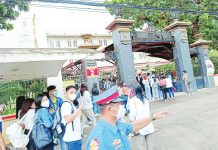 THERE ARE many definitions of the term “township” but the one that I like the most is the definition that a township is a division of a municipality with some corporate powers.
THERE ARE many definitions of the term “township” but the one that I like the most is the definition that a township is a division of a municipality with some corporate powers.
I like this definition, because the townships that we now have in the Philippines are owned by corporations that already have some corporate powers to some extent.
Stretching that definition, many village associations that already exist now are registered as private corporations that provide services to their own residents (in effect their stockholders), other than, and over and above the services that the municipalities would also provide.
Despite the apparent autonomy of these associations, it is very clear that they would still pay taxes to the municipal government, and to some extent, that is what is important to the latter.
Therefore, as it is already happening, it is allowable to build new townships that are practically independent of the municipalities in terms of public services, for as long as they would pay the taxes that are due to the latter.
The scope and coverage of the public services would of course depend on the agreements between the townships and the municipalities, but there would also be room for the mutual sharing of resources in some areas such as public safety.
In reality, there should be no reason why the fire department or the police department of a municipality could not enter a township in case of an emergency. Conversely, there should also be no reason why the fire units of a township could not help the municipal fire department as needed.
The smartest move that a new township developer could ever do is to coordinate and synchronize the laying down of all fiber optics, power lines, phone lines, water lines, gas lines, drainage pipes and sewerage pipes on the ground, so that there will be no more need for any more excavations after that.
This is also in line with the objective that there should no longer be any cables or pipes above ground, for safety and aesthetic reasons. Since it costs a lot of money to excavate over and over again, this could also for economical reasons.
If this coordination and synchronization could be done, then the developer might as well include already the excavation for the landfills, and the excavation for the water impounding, both being required by national laws.
Since new townships are often tagged as smart cities, it is incumbent upon their developers to make their townships as smart as possible, in terms of recyclability, energy, adaptability, connectivity and hydrology (REACH).
I invented REACH as a mnemonic device for easy recall. Although it is just my invention, each letter represents a goal that should be achieved in order for a new township to be considered smart. In reverse, it could be said that any new township that does not meet any of these five goals should be considered dumb.
Although I mentioned earlier that a new township should have a landfill, it would take many years to fill it up, for as long as there is full recyclability within.
Since the law already allows every locality to become an Independent Power Producer (IPP), a new township should be able to produce its own energy, using any practical means. It goes without saying however that the use of any fuel that is not renewable could not be considered smart, especially if these would pollute the air.
That said, the IPP should only tap renewable energy sources such as solar, wind, hydro and biomass, and the latter could include dendro. For good measure, renewable energy should not only be used at the community level, but also at the residential, commercial and industrial levels. However, the latter should only include light industries that are non-polluting.
Disaster Risk Reduction (DRR) and Climate Change Adaptation (CCA) are two sides of the same coin. In a manner of speaking however, these two sides has a cause and effect relationship, because CCA could be considered as the cause (or means) of DRR, the latter being the desired effect.
When combined, DRR and CCA would form the adaptability component. In reality however, rainwater collection, water impounding, wastewater recycling, drainage and sewerage have all something to do with adaptability. The water paradigm also has two sides of the same coin, because a new township should not only conserve water for sustainable use, it should also manage the flow of water to prevent floods.
It is already a foregone conclusion that connectivity is no longer a luxury because it is already a necessity, a basic need in other words. As it is now, the mantra of new townships is “Live-Work-Play”, and what that means is that these places should already adopt mixed use architecture.
Aside from being liveable, these places should also be walkable and bike-able. I could have said that these places would also need to be commute-able, but commuting may already be unnecessary if the local residents could work where they live, and live where they work. What would really make that possible is good connectivity.
Hydrology is the scientific study of the movement, distribution of water. Although the water paradigm is already part of the energy and the adaptability components, it should be treated as a separate component by itself. In much the same way that there are electric cooperatives already, there should also be water cooperatives. That way, the residents of the new townships will also be earning at the same time that they are consuming the water.
However, the business of the cooperative should not only include water for household use, but also for commercial, industrial and agricultural use. The latter should mean not just irrigation for rice lands, but also water for poultry, livestock and fisheries. The bottom line here is sustainability of food security at the township level, and somehow that also translates to adaptability.
Much has been said about using electric vehicles for local transportation, including for jeepneys and tricycles. Although that is a good idea, what is even a better idea is to use solar powered vehicles instead.
That is so because the electric vehicles as we know it now are still plugging into electric outlets that still get their power from the grid, meaning that the electricity being used is still generated from fossil fuels that are not renewable.
Actually, the common denominator is the battery that is being used. The batteries of the existing electric vehicles are charged from a power outlet. The batteries for the newer solar vehicles are charged directly from the sun, using solar panels. What could be smarter than that?/PN





